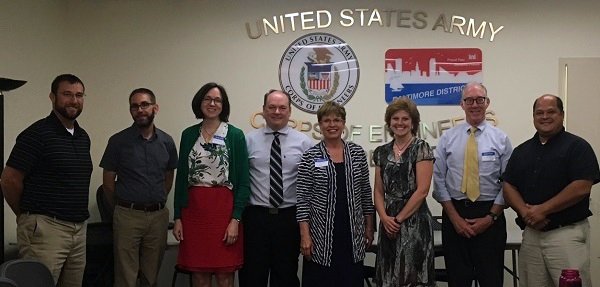
COG and U.S. Army Corps Baltimore District staff kick off the Coastal Storm Risk Management Study.
The U.S. Army Corps of Engineers, Baltimore District, signed an agreement July 18 with the Metropolitan Washington Council of Governments (COG) to begin an approximately $3-million, three-year study on possible ways to address coastal flooding and storm damage across more than 57 square miles in the District of Columbia and surrounding areas of suburban Maryland and northern Virginia.
The National Capital Planning Commission will serve as a study advisor and will help coordinate federal participation.
“As part of this study, we will investigate flood risk and identify ways to help protect vulnerable assets upon which the region relies,” said Col. Ed Chamberlayne, Baltimore District Commander. “We hope the results of this study will aid in the long‐term resilience and sustainability of these coastal communities, and reduce the economic costs and risks to both people and property associated with large‐scale flood and storm events.”
Coastal areas in metropolitan Washington contain a convergence of critical infrastructure that the region’s local governments, businesses, institutions and communities depend upon. This infrastructure includes water, energy and communication utilities; transportation hubs; federal buildings and military installations; national security facilities; and significant national monuments and cultural treasures.
This particular study, known as the Middle Potomac – Washington, DC and Metropolitan Area Coastal Flooding Feasibility Study, is a spin-off of the two-year North Atlantic Coast Comprehensive Study (NACCS) completed in January 2015 that was commissioned by Congress as part of the Hurricane Sandy recovery effort. The purpose of NACCS was to help local communities better understand their changing flood risks due to climate change and provide them tools to be better prepared for the future. The District is one of nine high-risk areas that was identified in NACCS as needing further analysis.
“We are eager to work with our partners to assess these particularly-vulnerable urbanized areas and identify ways to manage the coastal flood risk to communities and infrastructure,” said Dave Robbins, Baltimore District Coastal Program Manager. “This state-of-the-art analysis will expand on past studies by assessing a range of possible future conditions to account for uncertainty and changing risk over time resulting from climate and sea level change.”
The study costs will be split 50 percent from the Corps and 50 percent from COG and its cost-sharing partners.
“This study is a critical next step in helping local governments along the Potomac and Anacostia rivers mitigate the risks from future flooding in metropolitan Washington coastal areas,” said Chuck Bean, COG Executive Director. “The study will help ensure the protection of the region’s investments in critical infrastructure into the future.”
The study area includes portions of the District of Columbia; Prince George’s and Charles counties in Maryland; and Arlington, Fairfax, and Prince William counties, and the City of Alexandria in Virginia, all located along the Anacostia and Middle Potomac rivers. The northern boundary for the study area is Bladensburg along the Anacostia River, and Little Falls along the Potomac River in Maryland. The southern boundary is near Fort Washington along the Potomac River.
“Currently, the region lacks the tools to locally assess climate impacts on precipitation and groundwater, or to comprehensively understand how our infrastructure is vulnerable to flooding, coastal storms and sea level rise,” said Steve Walz, COG Department of Environmental Programs Director. “Many individual agencies and organizations have been studying and making their own plans on how to deal with such risks; however, they still rely upon shared utilities, facilities and services. Therefore, each entity is only as protected as the weakest link in our regional infrastructure system. This study will help us to address those critical issues.”
This effort will result in a set of recommendations, which the Corps and others could implement. Coastal flood risk management strategies outlined in the plan and the study’s resulting data sets are meant to be customizable to incorporate into local mitigation plans. The Corps and coastal communities could seek additional funding for recommended flood risk mitigation projects to help the region reduce its risk from coastal flood hazards.
If you have any information or datasets related to flooding or flood risk management that may be relevant to this study, including reports, photos or other digital data, as well as climate change impact analyses or studies, please share this information with the study team by sending an email to MetroDCCoastalStudy@usace.army.mil.
The U.S. Army Corps of Engineers, Baltimore District, delivers vital public and military engineering services; partners in peace and war to strengthen our nation’s security, energize the economy and reduce risks from disasters. Our Civil Works boundaries, covering the Chesapeake Bay Basin and the Susquehanna and Potomac river watersheds, extend from Maryland to New York.